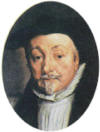|
The impeachment and
execution of Archbishop William Laud.

The
Bishops` Wars in Scotland were essentially
skirmishes in form, and a means of gaining time for Charles to gather
resources about him for a decisive battle. But his grand scheme depended
on money which he simply did not have nor could he obtain from his
dwindling support. Inevitably Charles had to face up to having to recall
Parliament. The “Long Parliament”, as it came to be called, met on
3rd November 1640, during which, on 18th December, Denzil Hollis impeached
Laud for high treason and other high crimes at the bar of the House
of Lords. It was 26th February 1641, before the twenty-six charges were
brought up by Sir Harry Vane the younger, son of the man who had doomed
Laud`s friend and accomplice in `thorough` government,
Thomas Wentworth, Earl of Strafford.
Prime among the
charges laid against Laud were the sensitive and emotive matters of
advising the king that he might impose taxes without consent of
parliament; seeking absolute power for the King, and himself and the
bishops contrary to law; with perverting the course of justice,
including bribery of the judges; imposing
new ecclesiastical canons that were contrary both to law and the Royal
prerogative; assuming a papal type power to subvert the true religion and
introduce popish superstition; and that he had been the principal
adviser and author of the recent wars against the Scots.
It was October before
Laud’s jurisdiction was sequestered by the House of Lords and about a year
later that all the rents and profits of his Archbishopric, in common with
those of all other eclesiastical offices, were seized for the use of the
Commonwealth. By November 1642, Civil War had broken out between the King
and parliament and Laud’s fate was by then probably sealed yet it was
spring before his property at Lambeth Palace was seized and an extensive
and thorough search made by Laud`s old adversary William Prynne. As in the
impeachment of Strafford, the accusers now dug deep into past activities
seeking any evidence of wrongdoing, possibly both real and imagined. On
12th March 1644, he was finally brought to trial before the House of Lords
where he stoutly defended himself and his actions, to such an extent that
he overawed many of his audience. The trial lasted twenty days and was
adjourned without coming to a decision. As with Strafford, it was the
Commons who intervened on 13th November, with a Bill of Attainder. This
was passed after just two days and sent up to the Lords who
also passed it on 4th January. On 10 January 1645 Archbishop William Laud
was beheaded on Tower Hill.
|